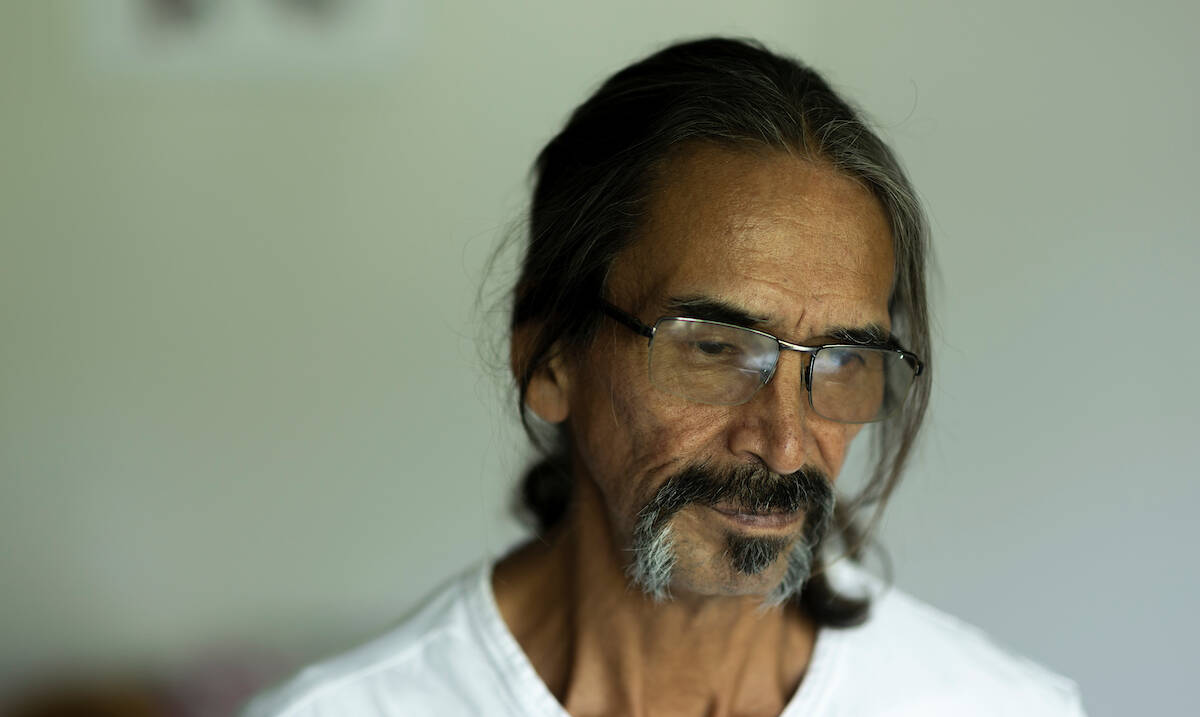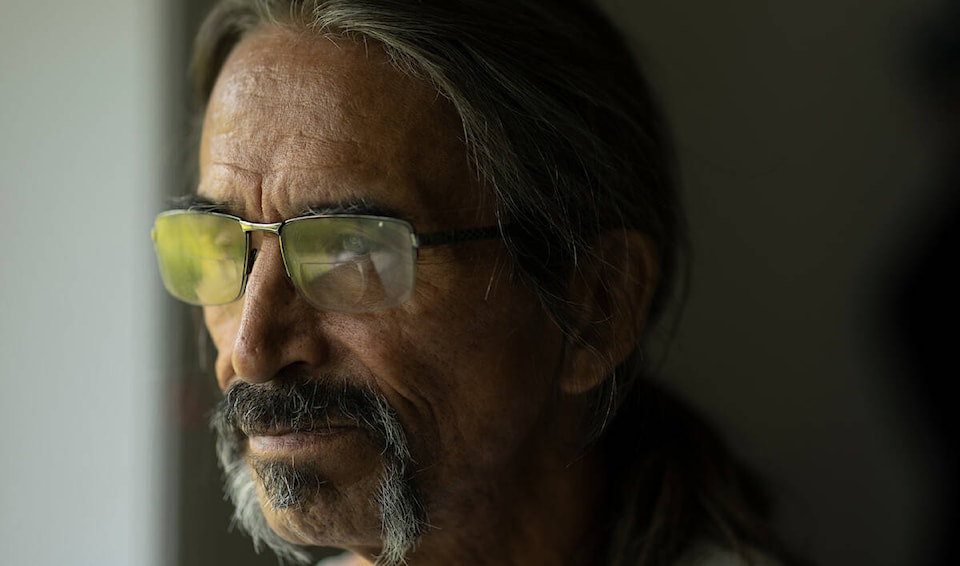This article contains descriptions of abuse and trauma that may be triggering. Support for survivors and their families is available. Call the Indian Residential School Survivors Society at 1-800-721-0066, or 1-866-925-4419 for the 24-7 crisis line.
When John Prevost sails into his hometown on Cormorant Island, a short trip from northern Vancouver Island town of Port McNeill, a blank space in the streetscape where a four-storey brick building once loomed brings him joy.
“As soon as the ferry came into Alert Bay, there was the residential school and I’d always be angry inside.”
Prevost, 62, is a survivor of St. Michael’s Indian Residential School.
The facility was built by the federal government in 1929 and was run by the Anglican church until it closed in 1975. But it loomed over the bay for nearly a century, becoming a dark reminder of colonial relations with Canada’s Aboriginal peoples.
When the Namgis Nation razed the building in 2015, demolition was marked with a healing ceremony attended by First Nations leaders, church leaders, politicians and former students.
Prevost was not there but he does remember the first time it didn’t loom over his arrival. He’d brought a couple of friends up. “When we came around the corner I was crying my eyes out … ‘look it’s not there’ … it made my heart lighter.”
The space serves as a reminder, but much like that emptiness, his individual memories of the school and subsequent day schools, foster homes and group homes are shrouded in what he calls emotional blackout. Many memories are told to him. What he does remember is violence and alcohol abuse at home. Followed by abuse and violence at residential school, day school and foster care.
Prevost’s Saanich studio apartment is now his nest and safe place, but Alert Bay is home.
What he knows of his family and childhood is learned second- and third-hand, sometimes from family in Alert Bay or family found over decades in the prison system.
He does remember being drunk at five, then the police came and took the five youngest boys, separating them into schools and foster homes.
“I was in St. Mike’s on the fourth floor – just awful,” Prevost recalled. It was two or three years of whipping, slapping and avoiding. A couple of his older brothers were there, and they looked after him as best they could. They advised him if someone said “come here” you run.
“I did a lot of running.”
Two or three years later, he was moved to Vancouver, further removed from his roots, into a life of foster and group homes. It wasn’t long after that he began his decades-long dance with incarceration.
By 11 or 12, Prevost recalled gathering the gumption to try and protect himself. For Prevost, foster home life included more slapping and being thrown down stairs. He reported the abuse to his social worker, telling the man they were beating him and not feeding him. The social worker believed the adults over the child.
“As soon as he left, boom, down the stairs,” Prevost said. “That’s when I burnt their house down. I threw all this newspaper they had on their pool table and I lit it. I walked away, went back to my room, and I was hoping somebody would wake up so I wouldn’t die with them.”
No one died in the fire.
Prevost got six months in a juvenille detention centre. “Six months turned into a year. I became a part of the furniture in the prison system up to, I don’t know, 10 years ago.”
Prevost felt safe there. He discovered additional ways to numb the pain of his past – cocaine and heroin among them. “Anything to keep me from not looking at myself.”
Despite the haze of his growing addiction, he remembers a comfort in being surrounded by people like him – people who felt anger and rage at the system. It’s also where he met much of his family.
Removed from home at five he had to fight to return for his mother’s funeral when he was 11. At 16, the system shifted Prevost to adult court and he wound up at Oakalla Prison (closed in 1979) on the Lower Mainland and surprisingly enough, that’s where he ran into his brother Jeff. It’s also where a guard remembered his dad, thrown in jail for speaking his own language, Prevost recalled.
While incarcerated he learned about Alcoholics Anonymous. The first time, Prevost was a teen looking to get out of his cell for a bit. “I went to a meeting and this old man was telling my story,” he said. “We all have similar stories in our disease.”
Meetings also helped him get out early. While he wasn’t yet ready for healing, Prevost learned treatment existed and was an option – one he eventually pursued.
While he still bears the marks of intravenous drug use, it’s been 20 years since his last overdose. “I shouldn’t be alive with all the addiction I went through.” Of 17 siblings (two sisters died at birth), four brothers remain. The others are dead of addiction, Prevost said, none of them would take treatment because of the associated stigma.
He also turned to family about three decades ago when he started doing a lot of doodling. While in Alert Bay for treatment, and with a little trepidation, he showed the drawings to his cousins. They were impressed with his early attempts and offered him tips and gave him pieces of their own work with the advice of “copy ours until you find yours.”
“So I did, for two or three years I was copying theirs and all of a sudden I started seeing my own art,” Prevost said. Decades later it remains a tool for healing – taming triggers that lurk every day.
Now an artist and a healer himself, Prevost has become a mainstay in places designed to help lift others. He’s an active volunteer at AVI Health and Community Services and Our Place Society, leading a healing circle and sharing his experience.
While his work adorns walls across the region, it’s just one approach to wellness. What has proved most helpful, and he looks forward to participating again, is a retreat for residential school survivors.
“The first one I did was overwhelming,” Prevost admitted. “Thirty-five of us in total, we all had our armour on when we first went there. They showed us this room where we’re going to be doing our healing.”
Three big buckets stood in the middle of the room. He learned later they were for the tissues for their tears.
“Right from the get-go, nonstop crying – nonstop cried our eyes out. It’s a good feeling,” he said. “It helped me go forward. “If I didn’t do this treatment I’d be with my brothers or I’d be dead.”
Happily settled into his Saanich nest for the last four years, Prevost’s walls are covered in art – his and others’ – and photos. One piece is a portrait created for him by a friend. Crafted of smaller images, residential school and other dark times dominate the bottom corner of the work, slowly lightening as it crosses the face stretching into brightness at the other far corner. It’s an image he uses to help explain residential schools to those who don’t understand. He started life in that dark corner and works every day to maintain the light.
This is part five in a special series prepared by Black Press Media. You can find more of the series and other articles on truth and reconciliation
READ MORE:
Do you have a story tip? Email: c.vanreeuwyk@blackpress.ca.
Follow us on and and like us on




